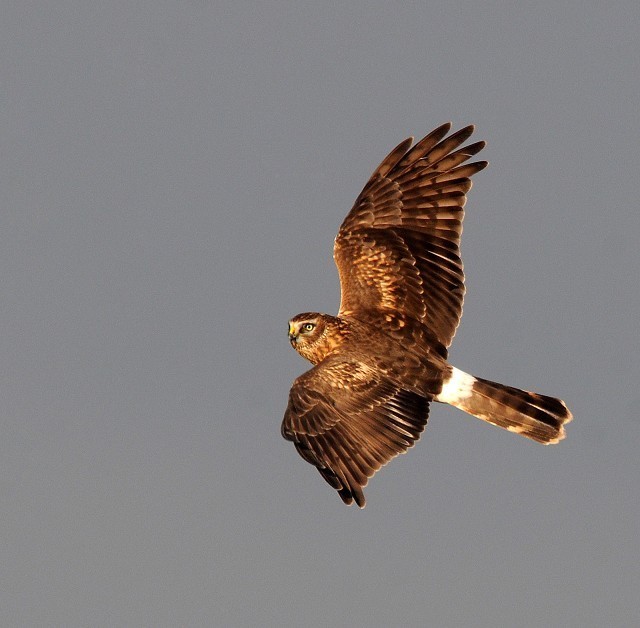English Hen Harriers 'four steps' from extinction
A 2011 joint survey of the English uplands by the RSPB and Natural England found that only four nesting pairs of Hen Harrier successfully raised young; all were on a single estate in the Forest of Bowland, Lancashire. This is believed to be the lowest population in England since they recolonised in the 1960s following extinction in the late 19th century. Historically, the Hen Harrier was widespread in England. A government-backed report — the Hen Harrier Conservation Framework — proved that illegal persecution on driven-grouse moors is the main factor restricting the growth of the Hen Harrier population in the UK. The framework reported that England's uplands could support at least 320 pairs of this bird of prey. Hen Harriers disappearing from England for a second time will see the government break its recent commitment in the revised England Biodiversity Strategy to avoid any human-induced extinctions before 2020.
Hen Harriers were formerly widespread in the UK, but persecution forced the mainland extinction of the species in Britain, and by 1900 it was confined in the UK to Orkney and the Western Isles of Scotland. In the 1940s, it recolonised mainland Britain, and two decades later it recolonised England. Hen Harriers sometimes prey on Red Grouse on upland shooting estates, making them unpopular on many grouse moors. Given the bird's potential for extinction in England, the RSPB and Natural England are appealing to grouse moor owners to support techniques being trialled to reduce predatory impacts on grouse from harriers.

Hen Harrier, undisclosed site, Nottinghamshire (Photo: Rob Smith)
A demonstration partnership project at Langholm Moor, in the Scottish Borders, is looking at the effectiveness of a measure known as 'diversionary feeding', where an alternative food supply is left for the harriers, so that the birds have a source of food and won't be tempted to take Red Grouse chicks. Early results look promising, enabling the birds to nest successfully without causing alarm to grouse moor owners and managers. Preliminary results show that no grouse chicks have been brought to monitored Hen Harrier nests in four years at the study site.
Martin Harper is the RSPB's Conservation Director. He said: "With only four pairs of Hen Harrier in England, this bird only has four steps before extinction and the Government has very little time to act to prevent breaking their promise. We believe the potential for diversionary feeding will provide a lifeline for the recovery of the English Hen Harrier and a way for grouse moor managers to maximise the number of grouse."

Hen Harrier, Minsmere RSPB, Suffolk (Photo: Jon Evans)
Recolonisation of the British mainland began in 1939 in Scotland and the birds have regained some of their former range, but they remain almost completely absent from land managed for intensive grouse shooting. The last 20 years has seen a perilous decline of an already tiny English population, to leave it barely clinging to existence in England. The RSPB has recently launched the Skydancer project with over £300,000 financial support from the Heritage Lottery Fund (HLF). The Skydancer project, which is designed to help the Hen Harrier recover across northern England, will provide a mix of community engagement and direct conservation work over four years to inspire people about this magnificent bird of prey. The Skydancer project is named after the male Hen Harrier's rollercoaster aerial display, known to many as skydancing.
The 2010 Hen Harrier survey recorded an estimated 646 pairs of Hen Harriers nesting in the UK and the Isle of Man. This is down from an estimated 806 pairs in 2004. The Hen Harrier is one of 52 species of bird that appear on the Red List of the Birds of Conservation Concern in the UK.

